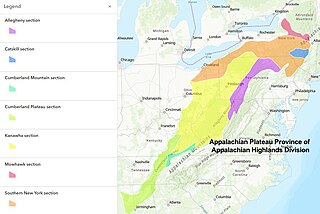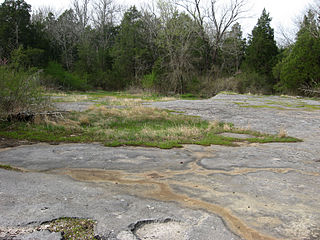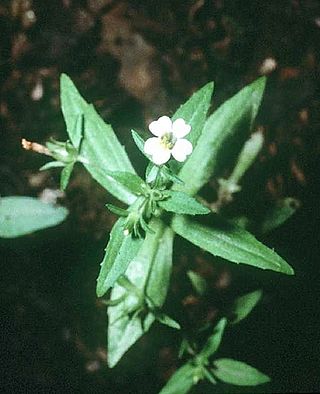
The geography of Alabama describes a state in the Southeastern United States in North America. It extends from high mountains to low valleys and sandy beaches. Alabama is 30th in size and borders four U.S. states: Mississippi, Tennessee, Georgia, and Florida. It also borders the Gulf of Mexico.

The Appalachian Mountains, often called the Appalachians, are a mountain range in eastern to northeastern North America. The term "Appalachian" refers to several different regions associated with the mountain range, and its surrounding terrain. The general definition used is one followed by the United States Geological Survey and the Geological Survey of Canada to describe the respective countries' physiographic regions. The U.S. uses the term Appalachian Highlands and Canada uses the term Appalachian Uplands; the Appalachian Mountains are not synonymous with the Appalachian Plateau, which is one of the provinces of the Appalachian Highlands.

The Edwards Plateau is a geographic region forming the crossroads of Central, South and West Texas, United States. It is named in honor of Haden Edwards. It is bounded by the Balcones Fault to the south and east; the Llano Uplift and the Llano Estacado to the north; and the Pecos River and Chihuahuan Desert to the west. San Angelo, Austin, San Antonio and Del Rio roughly outline the area. The plateau, especially its southeast portion, is also known as the Texas Hill Country.

The Appalachian Plateau is a series of rugged dissected plateaus located on the western side of the Appalachian Mountains. The Appalachian Mountains are a range that run from Nova Scotia in Canada to Alabama in the United States.

Agastache is a genus of aromatic flowering herbaceous perennial plants in the family Lamiaceae. It contains 22 species, mainly native to North America, one species native to eastern Asia. The common names of the species are a variety of fairly ambiguous and confusing "hyssops" and "mints"; as a whole the genus is known as giant hyssops or hummingbird mints.

A calcareous glade is a type of ecological community that is found in the central Eastern United States. Calcareous glades occur where bedrock such as limestone occurs near or at the surface, and have very shallow and little soil development. Due to the shallow soil and the extreme conditions created by it, trees are often unable to grow in the glades. This creates a habitat that is usually sunny, dry, and hot. Calcareous glade vegetation is more similar to that of a desert habitat than a grassland, being dominated by small spring annuals with occasional geophytic or succulent perennials.

Castanea pumila, commonly known as the Allegheny chinquapin, American chinquapin or dwarf chestnut, is a species of chestnut native to the southeastern United States. The native range is from Massachusetts and New York to Maryland and extreme southern New Jersey and southeast Pennsylvania south to central Florida, west to eastern Texas, and north to southern Missouri and Kentucky. The plant's habitat is dry sandy and rocky uplands and ridges mixed with oak and hickory to 1000 m elevation. It grows best on well-drained soils in full sun or partial shade.

Gratiola officinalis, the gratiole, common hedgehyssop, grace of God, Gratia Dei, hedge hyssop, hedge-hyssop, or herb of grace, is an ornamental plant in the family Plantaginaceae. It is a rhizomatous perennial herb native to Europe.

Gratiola is a genus of plants in the family Plantaginaceae. Most species are known generally as hedgehyssops. It includes 29 species native to temperate North America and Eurasia, and to Morocco, South America, Australia, and New Zealand. The genus was previously included in the family Scrophulariaceae.

Baccharis halimifolia is a North American species of shrubs in the family Asteraceae. It is native to Nova Scotia, the eastern and southern United States, eastern Mexico, the Bahamas, and Cuba.

Elsie Quarterman was a prominent plant ecologist. She was a professor emerita at Vanderbilt University.

Gratiola neglecta is a species of flowering plant known by the common name clammy hedgehyssop. It is native to much of North America, including most all of the United States and the southern half of Canada. It is generally found in moist to wet habitat. This is an unobtrusive annual herb producing a glandular stem up to about 30 centimeters tall. The lance-shaped to oval leaves are arranged oppositely about the stem. They are up to 5 centimeters long and sometimes toothed along the edges. The inflorescence is a raceme of nearly cylindrical tubular whitish flowers each about a centimeter long. At the base of each flower is a fringe of five pointed sepals. The fruit is a spherical capsule about half a centimeter wide.

Torilis japonica, the erect hedgeparsley, upright hedge-parsley or Japanese hedge parsley, is a herbaceous flowering plant species in the celery family Apiaceae. Japanese hedge parsley is considered both an annual and biennial plant depending on the biogeographical location. This means Japanese hedge parsley can complete its life cycle in either one or two growing seasons depending on habitat. Japanese hedge parsley is typically found in areas with disturbed soils, pastures, margins, open woodland, near waste sites, or right-of-way habitats. It can withstand a variety of habitats, thriving in partial and full shaded areas, but also withstanding habitats with full sunlight penetration. It is considered an aggressive invasive species in North America; invading a wide range of habitats due to its environmental tolerance and tendency to outcompete native vegetation. This species is considered a threat in several areas that causes problems relating to overall environmental health and stability. Aside from its environmental implications, T. japonica has potential to fight several cancers through a terpene it produces called Torilin, extracted from its fruits.

The Interior Low Plateaus are a physiographic region in eastern United States. It consists of a diverse landscape that extends from north Alabama across central Tennessee and Kentucky into southern Illinois, Indiana, and Ohio. Its natural communities are a matrix of temperate forests, woodlands, and prairies.

Viola egglestonii, commonly known as glade violet, is a species herbaceous plant in the violet family. It is native to a small area of eastern North America, only being found in limestone cedar glades of the Interior Low Plateau and Ridge and Valley ecoregions of Alabama, Georgia, Indiana, Kentucky, and Tennessee.

Calamovilfa arcuata, commonly known as Cumberland sandreed, is a species of flowering plant in the grass family. It is native to the southeastern United States, where it is found in river scour zones. Due to its specialized habitat, it has a highly localized range, found only on the Cumberland Plateau and in the Ouachita Mountains.

Stachys hispida, commonly known as hispid hedgenettle, is a species of flowering plant in the mint family (Lamiaceae). It is native to eastern North America, where it is found in Canada and the United States. Its natural habitat is in moist areas, such as alluvial banks, bottomland forests, and wet meadows.

Gratiola brevifolia, commonly called sticky hedgehyssop, is a species of flowering plant in the plantain family (Plantaginaceae). It is found in the Southeastern United States, where it has a scattered distribution. Its natural habitat is in wet acidic areas.

Gratiola floridana, the Florida hedge hyssop, is a species of annual forb native to the southeast United States. It grows in wet areas.



















